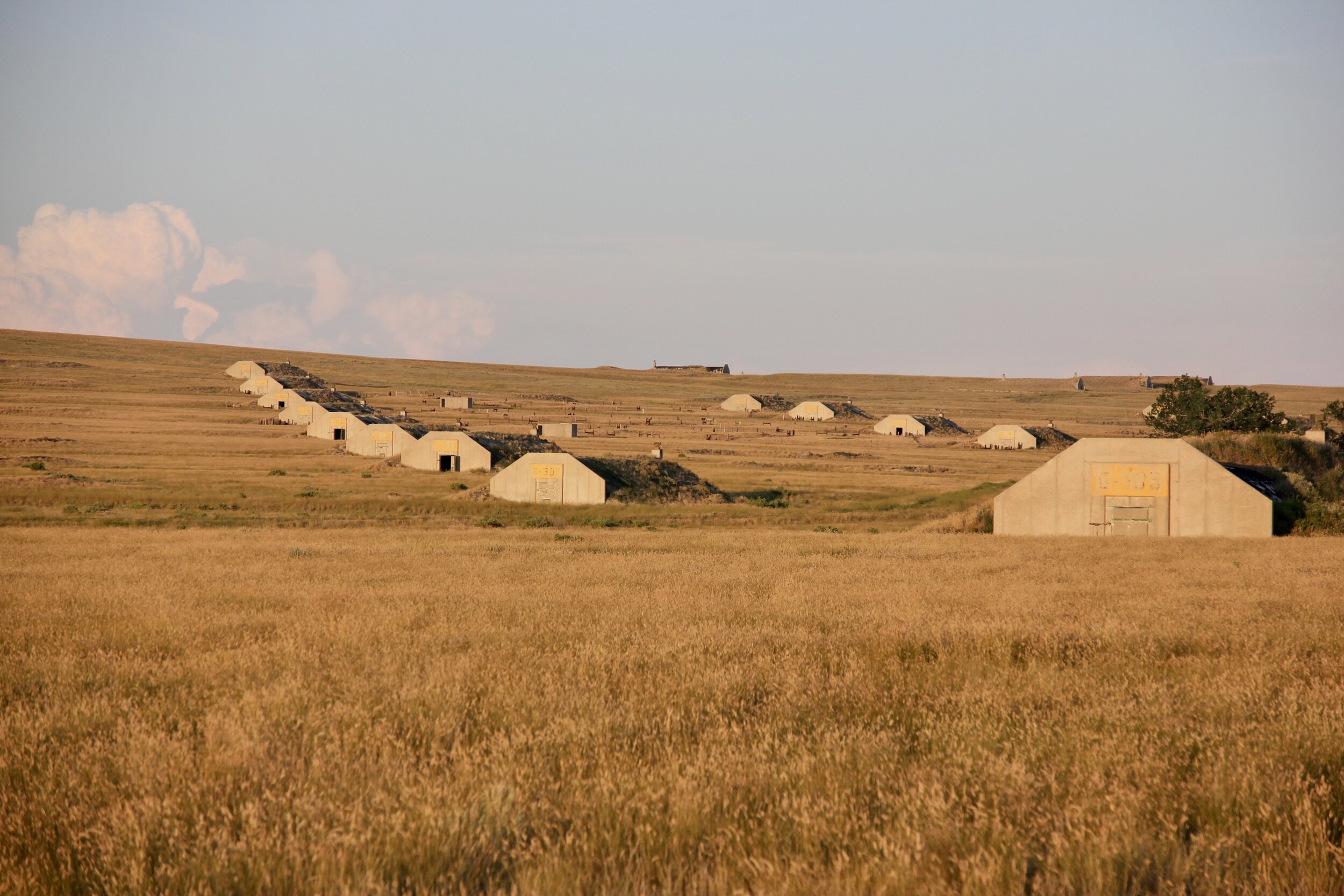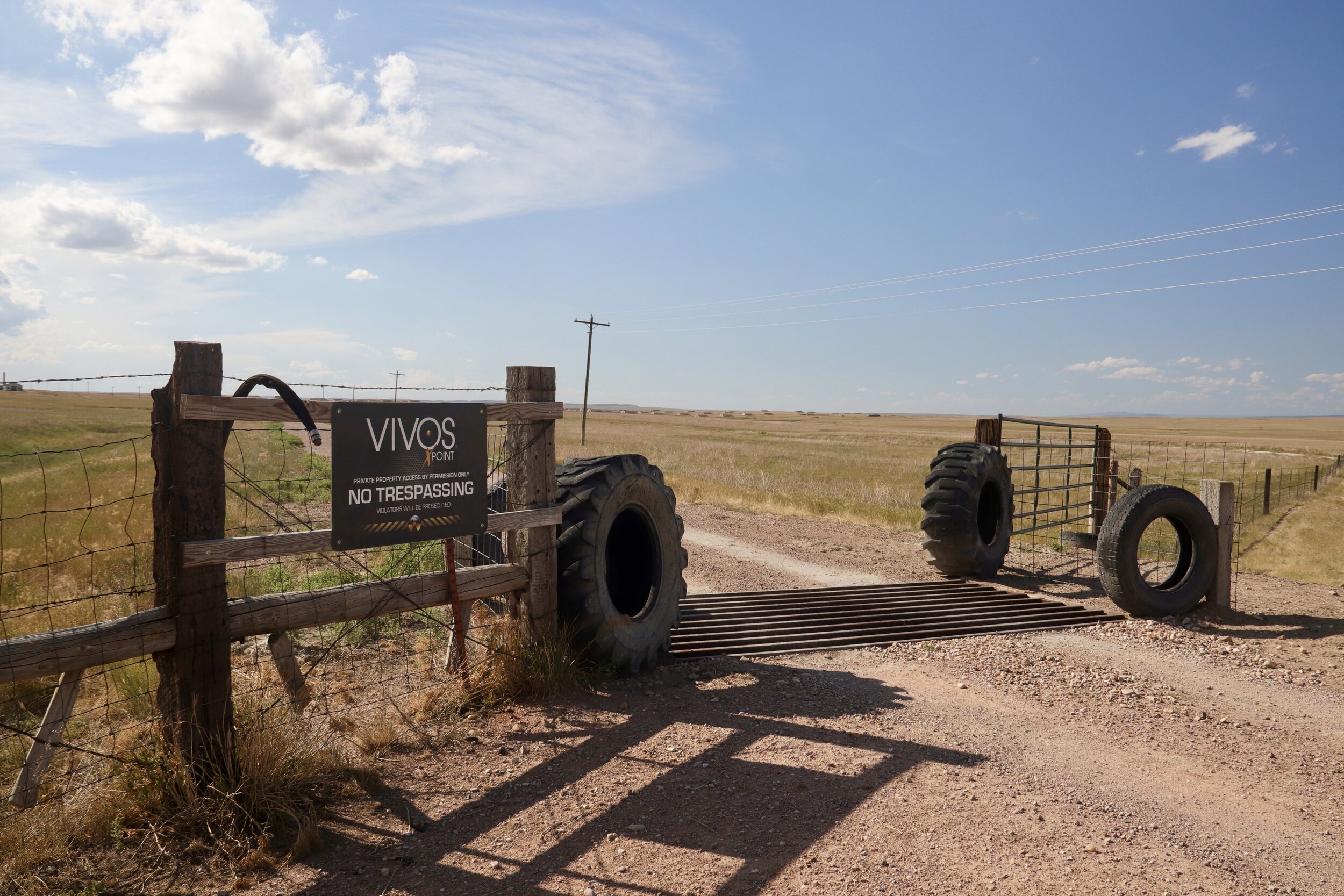
Black Hills Ordnance Depot - Igloo, SD
In mid summer, the Black Hills are literally a calming oasis compared to the vast plains that lie to the east. Yet I’m compelled to leave the cooling comfort of whispering pines and granite spires for something unusual and mysterious. Instead of aiming east and heading for home, I drive south and descend into rolling grassland. As the landscape opens up, temperatures climb into triple digits and cell service fades. I’m searching for things new to my eyes and there they are. Man made or natural? First there are a few. Then many. Then hundreds. Not crazy like hoodoos but uniformly bumpy like giant Braille. It takes miles of driving but now I see them for what they are.
Igloo is no longer owned by the Government although the US Army has a minor presence here in the form of test wells maintained by the Corps of Engineers. The wells are a legacy of the former storage and disposal of munitions containing conventional explosives as well as the blistering agent, Mustard gas, and the nerve agent, Sarin. The bumpy countryside is actually a vast, abandoned storage facility with 800 or so “igloos”, each constructed of poured concrete with a steel door and covered with earth.
Frankly, calling Igloo a storage facility doesn’t even do it justice. In addition to the concrete storage magazines, the 33 square mile complex once included all the amenities of a well-planned town. In addition to living quarters for over 1,000 people, Igloo (properly known as Black Hills Ordnance Depot) also boasted an Army hospital, a school district, community center, day-care center, movie theater, bowling alley and other mainstays of small-town America. These amenities were actually a necessity due to the remote and isolated location. Indeed, the isolation was also a necessity dictated by the mission of the Depot and the nature of items warehoused there.
BHOD was conceived, built and opened during World War Two with the mission of receipt, storage, issue and maintenance of ammunition. The depot also housed several hundred Italian prisoners of war beginning in 1943. The facility performed its mission through three wars and was eventually closed in 1967. All types of ammunition were stored here from small arms ammunition to artillery rounds, bombs and chemical weapons. The sprawling nature of the base along with its remote location in southwestern South Dakota provided a relatively safe buffer in case of a deadly mishap.
On two separate occasions I was able to tour the facility with the present owner as my guide. Curiosity seekers are advised not to trespass on this private land which is now used largely for cattle grazing. Much of the base is fenced with two rings of security and the main entrance (which is flanked by the symbol of the US Army Ordnance Corps as well as a symbol of the present ranch environment) leads past abandoned base housing, some of which has been moved off its piers to the Pine Ridge Indian Reservation.
Fox-holes - As you drive further into the complex, the munition storage igloos are prevalent and occupy the sloping plains by the hundreds. An interesting feature of this area are the "fox-holes" located at various intervals among the igloos. The fox-holes are small concrete rectangular structures and the idea appears to be, if somebody yells "Run for your life!", that's where you go.

Accidents, explosions and fatalities
The safety record at BHOD appears to have been pretty good, especially considering the items that were stored and handled there. Examples include artillery shells, air-delivered bombs, chemical munitions, and even warheads for Nike Ajax surface-to-air missiles (there were several Nike batteries located at Ellsworth AFB just east of Rapid City).
I could only find four references to accidental explosions as follows:
1. The first occurred in 1946 and it was a doozy involving the detonation of 38,500 phosphorus bombs after a forklift driver punctured one of the bomb cases thereby exposing the white phosphorus to air. Bombs were launched into the air while spewing their flaming contents and the main fire lasted for about 20 hours.
2. The second incident, occurring in 1950, was much more tragic and resulted in three fatalities when an explosion blew the top off an igloo and rained debris back on the four occupants. One survivor was pulled from the rubble which included chunks of concrete, steel, shrapnel and unexploded hand and rifle grenades.
3. Although the date is unknown, one worker was killed when a bomb containing mustard gas exploded. He was trying to defuze it with a hammer and chisel and was covered in mustard agent by the ensuing explosion. It is not known if he died from the explosion or from mustard gas burns but emergency vehicles and their personnel were contaminated in the rescue effort.
4. One worker was killed (again, date unknown) by an explosion while trying to dislodge primers from a furnace chimney.
Chemical Weapons, Nerve Gas
Chemical weapons were prevalent at BHOD and included munitions containing the following lethal agents:
VX - Highly toxic nerve agent originally developed by the British. Used as an area denial weapon and causes paralysis that ultimately kills by asphixiation. VX is slow to evaporate and highly persistent in the environment which means it can remain lethal for days after it is released.
GB - Also known as Sarin. Discovered by the Germans, its use and effects are similar to VX.
CG - Phosgene, a choking agent developed in Great Britain and used to great effect in World War I by the Germans as well as Allied forces.
CK - Cyanogen Chloride, a Cyanide based compound, is variously referred to as a blood, nerve or tissue toxin.
H - Mustard gas, a highly persistent blistering agent which was used to great effect in World War I, largely by the Germans, as an area denial weapon.

On-site disposal of munitions
There were three designated "Burning Grounds" (basically, exposed pits) at BHOD which were used to dispose of certain munitions that were no longer needed. At least one or two of the Burning Grounds were used to destroy nerve agents and chemical munitions which included the following:
H - Mustard gas
CK - Cyanogen Chloride
CG - Phosgene
In 1959, a kiln-type incinerator was constructed and was used to dispose of Mustard Gas and Cyanogen Chloride. Basically, the chemical contents of these munitions were incinerated and the bomb casings either buried on-site, recycled for future use or sold for scrap. The incinerator was dismantled in 1967 and buried on-site but the wash house (now mostly collapsed) is still located nearby.
Igloos and Italian POWs
The igloos were constructed of reinforced, poured concrete with the lower portion below grade, the arched roof covered with earth and a vented opening on top. The interior dimensions were approximately 30' x 90' X 13' tall and entry is via a hinged, steel door. A few igloos have interior walls embellished with pornographic artwork, historic inscriptions from workers, and evidence of some of the Italian POWs who lived at BHOD. Several hundred of the Italians arrived during World War 2 and were placed under guard until Italy surrendered in 1943. After that, many of the Italians were organized into service companies and worked at the depot.
BHOD today - Summer 2020








